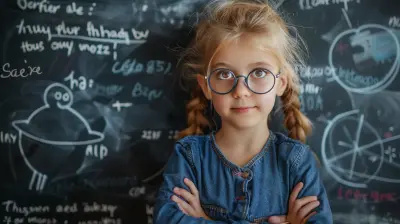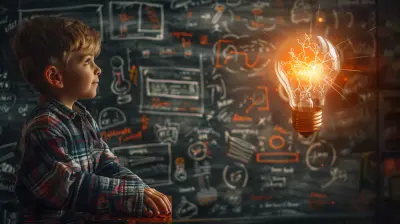Developing Problem-Solving Skills Through Interdisciplinary Learning
4 November 2025
Ever tried fixing a leaky faucet with a butter knife? It might work (kinda), but it’s definitely not the best tool for the job. That’s how we often treat learning—we compartmentalize subjects as if they operate in isolation, when in reality, the world doesn’t play by those rules. Enter: interdisciplinary learning—a mash-up of math, art, science, and more—all working together like a dream team to make you a creative, agile problem-solver.
In this blog post, we’ll dive deep into how interdisciplinary learning isn't just a buzzword thrown around in education circles. It’s a powerful way to nurture real-world problem-solving skills—and honestly, it’s way more fun than sitting through another rote math drill or memorizing facts with flashcards. Let’s get quirky with it.
Wait, What Even Is Interdisciplinary Learning?
Glad you asked! Imagine your brain is a toolbox. Traditional learning gives you a screwdriver, a hammer, and maybe a wrench—but all in separate compartments. Interdisciplinary learning dumps that toolbox out on the table and shows you how all the tools can be used together to build something awesome.It's about connecting the dots between different subjects to tackle problems from multiple angles. Think of it like combining your inner detective, artist, and engineer to solve a mystery. Sherlock Holmes meets Bob Ross meets Elon Musk.
The Problem With Traditional Problem Solving 🤷♂️
Most schools teach in silos. Math here. History there. Science way over there. But real-life problems don’t come with labels or chapter headers.Let’s say you’re trying to design a sustainable water filter for a developing region. What do you need to know?
- The science behind water purification
- Engineering to build the prototype
- A grasp of geography and social sciences to understand the local needs and environment
- A little math for measurement, budgeting, and efficiency
- Some communication and writing skills to share the project and get funding
Boom. That’s interdisciplinary learning in action. It's like Avengers Assemble—but for your brain.
Why Interdisciplinary Thinking = Superpower Mode 🦸
So, why bother mixing subjects? Because mashups are magical. Just like peanut butter and jelly, combining ideas from different fields makes them stronger and more delicious (intellectually speaking, of course).Here are some solid reasons why developing problem-solving skills through interdisciplinary learning is the secret sauce:
1. It Mirrors the Real World
No real-world job sticks to one subject. Want to be a game developer? You’ll need coding skills, creative storytelling, logic, and some snazzy artwork. Working in healthcare? Beyond biology, you’ll need communication, ethics, critical thinking, and probably a calculator.2. It Boosts Creativity
Mixing disciplines sparks creative thinking. Honestly, some of the best ideas come from smashing two unrelated concepts together. Ever heard of bio-mimicry? That’s using animal adaptations to design better human tech. Like how shark skin inspired swimsuit fabric.3. It Strengthens Cognitive Flexibility 🧠
Interdisciplinary learners get used to jumping between ideas and mental frameworks. That means they can adapt better, pivot faster, and think on their feet. In today’s world of constant change, that’s gold.4. Encourages Empathy and Broader Thinking
When students learn how different disciplines see a problem, they also learn how different people do. That multicultural, multi-perspective lens builds empathy—an underrated (but vital) skill in any collaborative endeavor.
Real-Life Examples That’ll Blow Your Mind 💥
Still not convinced? Let’s look at some examples where interdisciplinary genius saved the day.The NASA Example 🚀
NASA doesn’t just hire rocket scientists. They need psychologists to help astronauts cope during long missions, nutritionists for diet planning, engineers, computer scientists, and even artists for visualization and design.They used interdisciplinary approaches to solve the Apollo 13 crisis. Teamwork, real-time engineering, and out-of-the-box thinking helped bring those astronauts home safely.
Leonardo da Vinci—The Ultimate Renaissance Guy
Leonardo wasn’t just an artist. He was also a scientist, engineer, and inventor. His paintings were deeply influenced by his anatomical studies. His inventions stemmed from his observations of nature and deep understanding of mechanics. He didn’t see boundaries between disciplines—and that made his work groundbreaking.Medical Diagnosis and Communication
Doctors who understand both medicine and psychology explain complex diagnoses more clearly. They’re also more empathetic with patients. Combining technical knowledge and human understanding leads to better healthcare outcomes.How Schools Can Foster Interdisciplinary Problem-Solving
Okay, cool stories. But how do we actually do this in schools?Project-Based Learning (PBL) 🛠️
Projects are like real-world test drives. They naturally blend subjects. For instance, building a model city requires math, physics, geography, and economics—and a good amount of teamwork and creativity.Thematic Units
Instead of teaching subjects separately, schools can organize units around a theme. "Water," for example, could include:- Chemistry (molecular composition)
- Geography (water sources)
- Art (painting water scenes)
- Literature (poems about rain)
- Technology (irrigation systems)
- History (civilizations built around rivers)
See? One theme, endless connections.
Collaborative Teaching
Imagine a science teacher, an art teacher, and a history teacher walking into a classroom… No, it’s not a joke. It’s a dream team. Teachers from different areas can co-plan lessons to show how disciplines overlap.Makerspaces and Innovation Labs
These are literal playgrounds for problem-solving. With 3D printers, coding kits, art supplies, and robotics tools, students can mix and match to create whatever wild ideas they dream up.But Wait… Is It Really That Effective?
Research backs it up. Studies show that students engaged in interdisciplinary projects show higher retention, deeper understanding, and better attitude toward learning.A report by the National Academies of Sciences even suggests that interdisciplinary education better prepares students for future careers—especially in STEM and innovation-heavy fields.
More importantly, students say they enjoy learning more when it means something. Solving real problems makes them feel like what they’re learning has purpose. And let’s face it, we all want to feel like what we’re doing matters.
So, What Can YOU Do?
You don’t need to wait for your school or college to restructure their entire curriculum. Whether you're a student, teacher, or lifelong learner, here’s how to hack your own learning experience:1. Follow Your Curiosity
If you’re researching a topic for school, take it five steps further. Look at it from other angles. Writing about climate change? Dive into the science, yes—but what about the politics, ethics, art, or historical context?2. Start Passion Projects
Tinker with personal projects that blend your interests. Love coding and storytelling? Create an interactive novel. Like biology and art? Draw anatomy diagrams or make educational comics.3. Collaborate with Diverse People
Surround yourself with people who think differently. Interdisciplinary learning isn't a solo game. Talking to someone outside your usual circle can spark new insights.4. Ask Weird Questions
Channel your inner four-year-old. Don’t just ask “how?”—ask “why?” and “what if?” All innovation starts with a curious question."What if we could learn calculus by choreographing dance routines?"
Now that’s an idea.
Final Thoughts: Become a Mental Swiss Army Knife 🧰✨
In a world that’s constantly changing, those who can connect the dots across disciplines will be the ones to lead the charge. Developing problem-solving skills through interdisciplinary learning isn’t about being a jack-of-all-trades. It’s about being a master connector—someone who sees patterns, adapts quickly, and brings fresh ideas to the table.So the next time you’re faced with a tricky problem, don’t just reach for one tool. Dump out the whole toolbox. Chances are, the solution lies somewhere between math, art, philosophy, and your favorite TikTok tutorial.
And hey, you never know—your next big “aha!” moment might come while you're doodling chemical equations in the margins of your English notes.
all images in this post were generated using AI tools
Category:
Problem SolvingAuthor:

Monica O`Neal
Discussion
rate this article
1 comments
Zevon McFarlane
Great insights! Interdisciplinary learning truly enhances problem-solving skills by fostering creativity and collaboration. Excited to see how these approaches can transform education for future innovators!
November 5, 2025 at 11:44 AM

Monica O`Neal
Thank you for your positive feedback! I'm glad you found the insights valuable. Indeed, interdisciplinary learning can be a game-changer for fostering creativity and collaboration in education.


